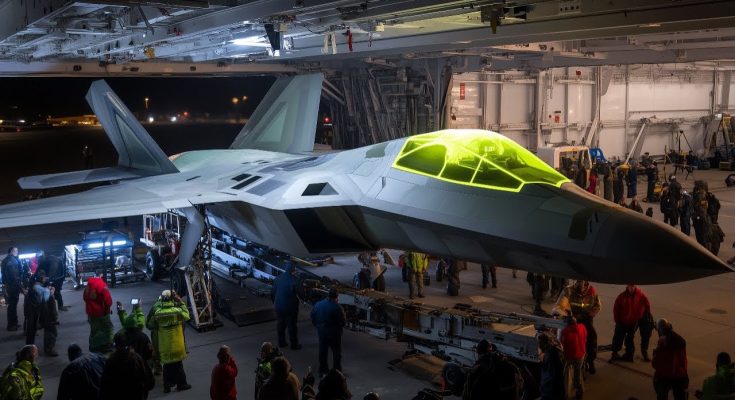The F-45 Condor is a next-generation stealth fighter jet that has captured the attention of defense experts worldwide. With its highly classified features and advanced technology, it is being touted as a potential game-changer in the world of military aviation. Built by Lockheed Martin and the U.S. Air Force, the F-45 Condor is designed to carry out a range of critical missions, from air superiority to strike operations, all while remaining undetectable to enemy radar. Its stealth, speed, and versatility have Russia and China on edge, as both nations strive to counter the growing capabilities of the U.S. military.
The Stealth Factor: Invisible to Radar
At the heart of the F-45 Condor’s design is its cutting-edge stealth technology, which is a significant leap forward from previous aircraft like the F-22 Raptor and F-35 Lightning II. The F-45’s shape, materials, and advanced coatings reduce its radar cross-section to nearly zero, making it virtually invisible to enemy radar systems. This gives the F-45 a critical advantage in combat, allowing it to penetrate heavily defended airspace without being detected, an essential feature for deep-strike missions and high-value target engagements.
Additionally, the F-45’s low infrared signature makes it difficult for heat-seeking missiles to lock onto the jet. This combination of stealth features enables the Condor to carry out precision attacks or intelligence-gathering missions in hostile environments with a much lower risk of interception.
Speed, Agility, and Range: The Perfect Mix
The F-45 Condor boasts exceptional speed and agility, thanks to its state-of-the-art engines and aerodynamic design. Capable of reaching speeds greater than Mach 2.5, the Condor can engage enemy targets quickly, outpace incoming threats, and maneuver effectively in dogfights. This speed also provides the aircraft with incredible range, allowing it to operate far beyond the reach of conventional air defense systems and even conduct long-range precision strikes on enemy ground targets.
Its design incorporates advanced avionics that give it superior situational awareness. The F-45 is equipped with an array of sensors and systems that allow it to communicate with other military assets, such as drones, satellites, and manned fighter jets, ensuring maximum efficiency in joint operations. It can seamlessly integrate into network-centric warfare environments, which are becoming increasingly important in modern military strategy.
Russia and China on Edge
The capabilities of the F-45 Condor have sent shockwaves through the defense strategies of countries like Russia and China. Both nations have made significant investments in next-generation aircraft and advanced missile systems to counter U.S. air superiority. However, the F-45’s combination of stealth, speed, and versatility represents a direct challenge to their efforts, forcing them to rethink their strategies.
For Russia, the introduction of the F-45 Condor represents a new level of competition in the air, particularly in terms of long-range strike capabilities and deep penetration missions. The Russian Air Force’s Su-57 and other advanced fighters may struggle to compete with the Condor’s stealth and speed, especially in contested airspace where their radar systems are ineffective against the F-45’s advanced stealth features. In addition, the S-400 missile defense systems, which Russia prides as one of its most formidable air defense solutions, may not be able to track or intercept the F-45 due to its extremely low radar cross-section.
China, too, has been investing heavily in its own stealth aircraft, such as the Chengdu J-20. However, the F-45 Condor poses a significant challenge to China’s aerial dominance in the Pacific region. The Condor’s ability to operate undetected at long ranges and conduct high-speed strikes could limit China’s freedom of operation, particularly in contested regions like the South China Sea or Taiwan Strait. The potential for the F-45 to quickly strike critical infrastructure or military assets before China can mount an effective defense is a strategic concern for Chinese military planners.
Tactical Advantages and Future Implications
The F-45 Condor’s versatility also extends to its role as a multi-mission platform. While its primary focus is air superiority and precision strikes, the F-45 can also be used for intelligence gathering, suppression of enemy air defenses, and electronic warfare. Its advanced radar and communication systems allow it to act as a force multiplier, coordinating with other U.S. military assets, such as drones and surveillance satellites, for coordinated strikes and real-time intelligence sharing.
The arrival of the F-45 Condor could significantly shift the global balance of power, as it provides the U.S. with an unmatched tool for strategic deterrence and force projection. The aircraft’s low operational cost and enhanced survivability make it an attractive asset for long-term defense plans, as it can carry out sustained operations in contested regions without risking valuable manned aircraft.
Conclusion
The F-45 Condor represents the future of U.S. airpower, combining stealth, speed, and versatility into a single platform capable of executing a wide range of missions with unprecedented effectiveness. Its technological advancements are set to disrupt the global air defense landscape, leaving countries like Russia and China scrambling to develop countermeasures. With its potential to redefine modern warfare, the F-45 Condor is undoubtedly a threat that has both rivals and defense experts on edge, and it will continue to shape military strategies for years to come.



